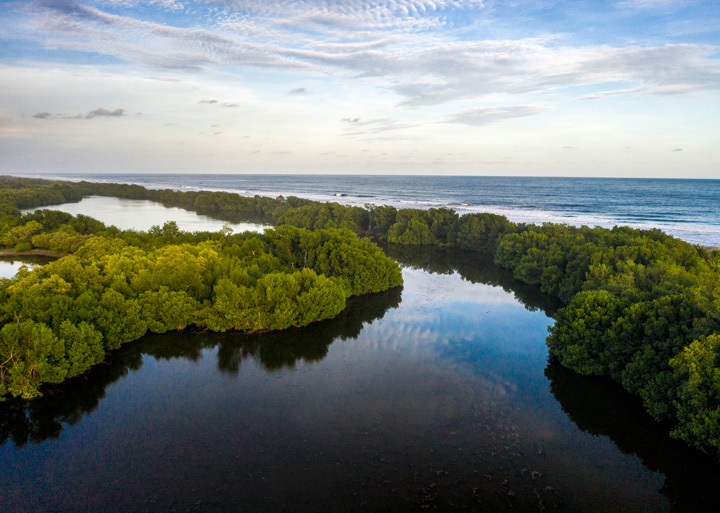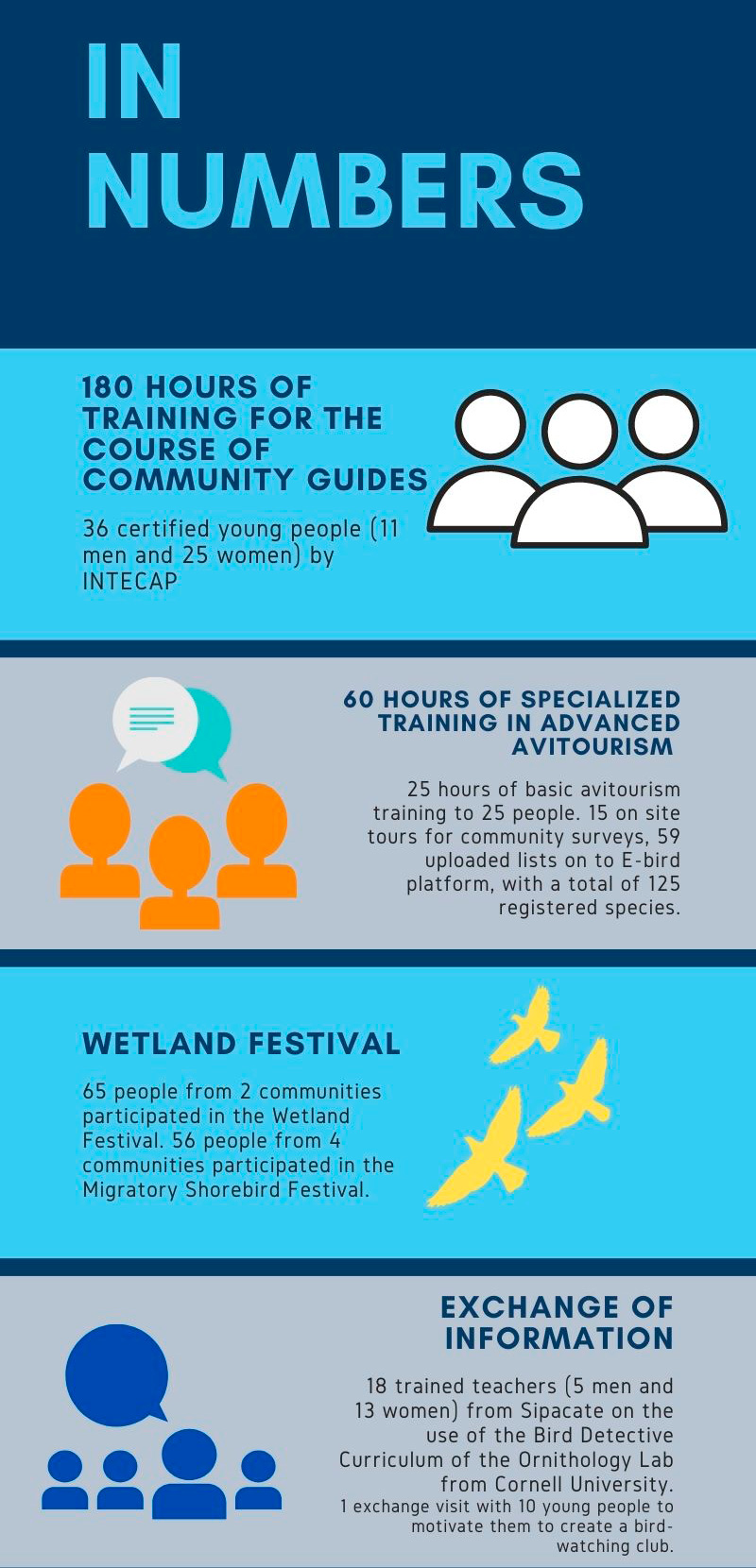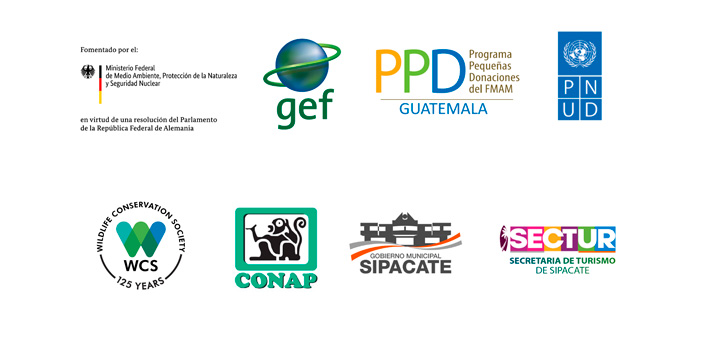Capacity building for young people from Sipacate, Escuintla
Located in the department of Escuintla, the coastal area of Sipacate-Naranjo is one of the most representative conservation areas in the Pacific of Guatemala. It has a variety of ecosystems such as mangroves, key to the growth of shrimp and fish, and fundamental to the local economy. In addition, it has unique sites such as the Poza del Nance, where you can see the green turtle (Chelonia mydas) that comes to feed, rest and possibly reproduce before its journey to the sea.
Sipacate-Naranjo is an important site for hundreds of migratory birds that every year use their habitats to feed and rest for a few months. There are various local birds that, alongside the migratory birds, give the tourist a unique experience. Up to 200 species can be seen between resident and migratory. Among those that stand out the White-bellied Chachalaca (Ortalis leucogastra), the Yellow-naped Parrot (Amazona auropalliata), Reddish Egret (Egretta rufescens), Roseate Spoonbill (Platalea ajaja).
Despite its importance, a large percentage of the local population (an estimated 20,000 people) remains on the poverty line and needs various economic activities to survive. In the case of young people, the situation is more complicated: after finishing school, they have to choose between staying in their community or looking for work and study opportunities.
The Wildlife Conservation Society (WCS) has worked on different projects since 2017, supporting governmental and non-governmental organizations for capacity building. Taking into account the great potential of Sipacate-Naranjo, WCS with the support of the PPD Small Donations Program, began in May 2020, the project to create capacities in ecotourism in the communities of Sipacate-Naranjo, this in order to support them in their training and that in the short term they can diversify their activities to develop and contribute to the local economy.
The project focused on 4 main objectives:
1.Strengthen the capacities of community youth in biodiversity and avitourism issues.
To do this, we had the experience and collaboration of the Technical Institute for Training and Productivity (INTECAP), which trained 40 young people as Community Guides, of which 36 managed to obtain their final certificate. The training process lasted 4 months and 180 hours of work.
As a result 15 young people were trained in bird tourism and learned to identify both migratory and resident birds. Guatemala is highly visited by tourists specialized in bird watching and the Pacific coast has great potential to receive and promote bird tourism. During this period, the young group learned the keys elements to identify families of birds and at least the 50 most common species in the Pacific, using platforms such as EBird.
In the words of the beneficiaries:
“I learned that there are 100 species of birds here, between migratory and local. I only knew two or three ”. Celeste Yubiana Rodas Castañeda
“It is a great support that they are giving us. One really learns a lot of things that we did not know. We have to take care of the habitat of the birds, because what we have here is something very precious ”. – Ludim Adiel Hernández Castañeda
2. Sensitize the population about the importance of conserving wetlands:
Different activities were carried out with the community of Sipacate, including teachers, local leaders (Community Development Council), children and the general population, with the aim of raising awareness of the importance of the area, promoting local pride and conservation of the area..
During the project, two important festivals stood out: the first on Wetlands on February 17 and 18, 2021, and the second on migratory and shorebirds in May 2021. With a total of 112 participants, most of them boys / girls and housewives .
Tours of two and a half hours were made in which 4 stops were made at key places to visit: the interpretive mural of shorebirds, the Poza del Nance for observation of sea turtles, importance of the mangrove and muddy planes, migratory birds, residents and salt mines.
“This festival has been very important, because we had people who had not visited the Sipacate-Naranjo National Park.” Lady Zulema Blanco
“It is of the utmost importance to educate children, since they are the future, the generation that will replace the one that is, and that is why we promote this with children and teach them the importance of caring for birds.” – Silvia Alvarado
3. Implement a pilot program for community monitoring of aquatic birds in the Sipacate-Naranjo National Park
In total 15 young people trained in bird tourism have participated to carry out at least 3 monthly visits during the months of March to June 2021 and are able to keep record of all the birds found. Once confirmedthey are entered in the eBird platform and shared with the National Council of Protected Areas. In these three months, a total of 125 species and about 8,379 individuals have been recorded. Endangered species such as the orange-fronted parakeet (Eupsittula canicularis), the Red Knot (Calidris canutus), the Semipalmated Sandpiper (Calidris pusilla) and the Reddish Egret (Egretta rufescens) have been reported.
During the month of June 2021, 18 teachers were trained in the use of the Bird Detectives curriculum developed by the Cornell University of Ornithology. This activity was of great interest to the teachers since the activities are fun and help to integrate students to become more familiar with the observation and conservation of birds in their communities.
4. Laying the foundations for the establishment of a youth community Bird Tourism Club in Sipacate Naranjo.
Sustainability:
To ensure the sustainability of the initiative, the organizational capacities of the young group have been strengthened to form a Bird Tourism Club. As a first step, young people with great interest in bird tourism were identified. They were invited to participate in an exchange visit between two bird tourism clubs and experts on this subject coming from Antigua Guatemala and Sololá to learn from their past experiences and challenges.
“My mentality changed a lot, because before we didn’t know many things and now we know about birds.” – Kimberly Viviana Cardona Pichiyá
“The conservation of species is very important, both fauna and flora, because it benefits human beings in one way or another.” – Lady Zulema Blanco
The project involved strategic partnerships with key institutions such as the National Council of Protected Areas (CONAP) and the Municipality of Sipacate-Naranjo. We hope that CONAP is able to continue monitoring the area and that in the near future new opportunities will arise with other institutions such as INGUAT to continue promoting coastal marine protected areas with tourism potential in the Pacific.
“Community support is very important to continue promoting the conservation and sustainable management of biological diversity in the marine and coastal zone of the Pacific. The articulated work and institutional synergies contribute to the strengthening of the governance and livelihoods of local communities,” José Moreira, coordinator of the marine program at WCS in Guatemala.
“This initiative is supported by the Small Grants Program of the Global Environment Facility implemented by UNDP within the framework of the Global Support Initiative for ICCAs”












